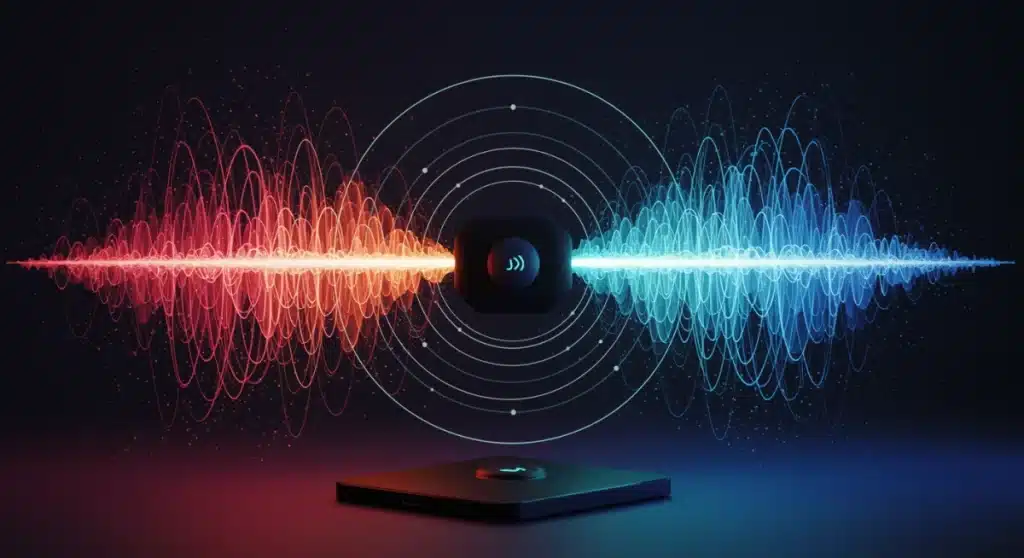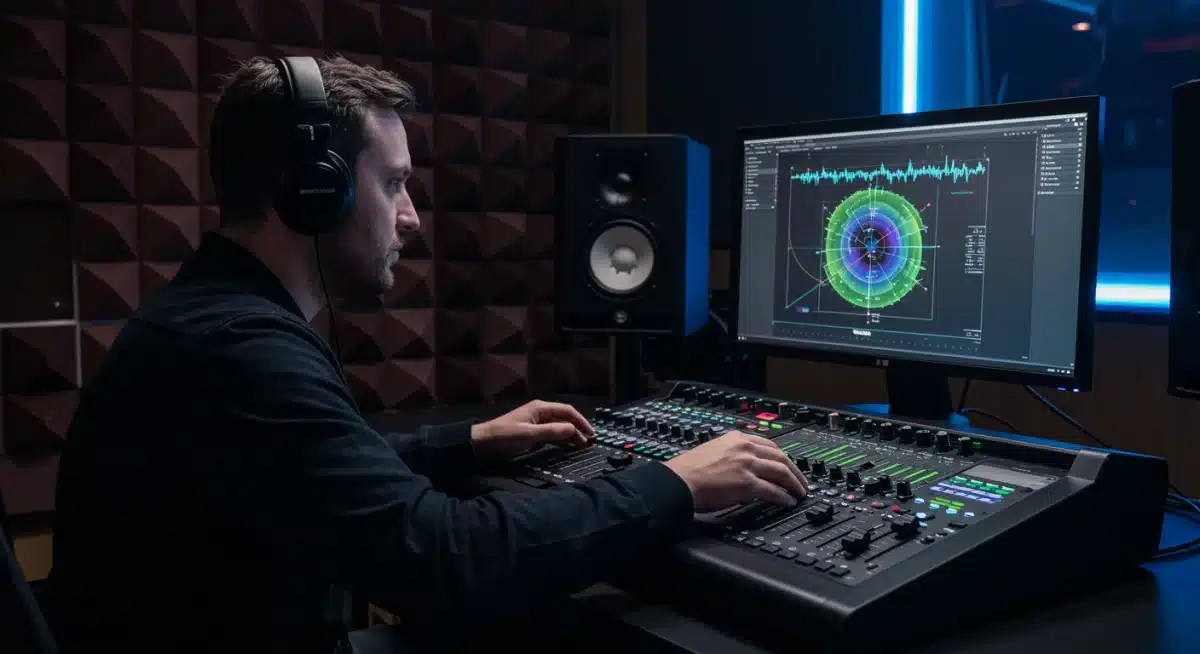The Sound Design Revolution: 2025 Tech & Immersive Streaming Audio

The sound design revolution is reshaping streaming, with 2025 technologies crafting immersive audio that redefines audience engagement and elevates storytelling to new, unprecedented levels.
The landscape of digital entertainment is undergoing a seismic shift, particularly in how we experience audio. The year 2025 marks a pivotal moment in The Sound Design Revolution: How 2025 Technologies Are Crafting Immersive Audio for Streaming Hits, fundamentally altering audience engagement and storytelling. This revolution is not just about louder sound, but about creating an enveloping, three-dimensional auditory experience that pulls viewers deeper into their favorite shows and movies.
The Rise of Spatial Audio in Streaming
Spatial audio has rapidly moved from a niche technology to a cornerstone of premium streaming experiences. As of early 2025, major platforms are increasingly adopting spatial audio formats, offering subscribers unparalleled soundscapes. This shift impacts everything from blockbuster films to episodic series, ensuring that every whisper and explosion is precisely placed within a virtual 3D space, enhancing realism and emotional impact.
The technology behind spatial audio involves sophisticated algorithms that simulate sound sources from any direction, including above and below the listener. This goes beyond traditional surround sound, which typically limits audio to a horizontal plane. The integration of spatial audio into consumer devices, such as smart TVs, soundbars, and headphones, has made this immersive experience accessible to a broader audience, driving its rapid adoption.
Key Technologies Driving Spatial Audio Adoption
- Object-Based Audio: Unlike channel-based systems, object-based audio treats individual sound elements as ‘objects’ with metadata, allowing them to be precisely positioned and moved in a 3D space regardless of the playback system.
- Head-Related Transfer Functions (HRTFs): These functions model how the human ear perceives sound from different directions, crucial for creating convincing virtual acoustics, especially in headphone-based spatial audio.
- Advanced Codecs: Next-generation audio codecs are essential for efficiently compressing and transmitting the complex data required for spatial audio without sacrificing quality.
AI’s Transformative Role in Sound Design
Artificial intelligence is no longer a futuristic concept but a practical tool actively shaping the sound design process in 2025. AI-driven tools are revolutionizing how audio is created, mixed, and mastered for streaming content. From generating ambient soundscapes to enhancing dialogue clarity, AI is streamlining workflows and opening up new creative possibilities for sound designers worldwide.
One significant application of AI is in intelligent sound generation. AI algorithms can analyze visual cues and script context to suggest or even create appropriate sound effects and background music, significantly reducing production time. Moreover, AI-powered mixing assistants are helping engineers achieve optimal balance and spatialization, ensuring a consistent and high-quality audio experience across diverse playback environments.
AI-Powered Sound Design Enhancements
- Automated Foley Generation: AI can analyze video footage and automatically generate realistic foley sounds, such as footsteps, rustling clothes, or impacts, saving countless hours in post-production.
- Dialogue Enhancement: Machine learning models can isolate and enhance dialogue, removing background noise and reverberation, which is critical for clear storytelling in complex audio mixes.
- Adaptive Soundscapes: AI allows for dynamic soundscapes that adapt in real-time to narrative changes or user interactions, offering a more personalized and immersive experience.
The Impact of Dolby Atmos and Competitors
Dolby Atmos continues to be a dominant force in the immersive audio space, particularly for streaming services. Its object-based approach has set a high standard for what consumers expect from premium audio. By 2025, Dolby Atmos is ubiquitous across major streaming platforms, from Netflix to Disney+, and is supported by a growing array of consumer electronics, solidifying its market position.
However, the immersive audio landscape is not without competition. DTS:X offers a similar object-based audio experience, particularly strong in the home cinema market. Furthermore, proprietary solutions from tech giants like Apple with its Spatial Audio for AirPods, demonstrate a push towards personalized, device-specific immersive experiences. This competition is healthy, driving innovation and pushing the boundaries of what’s possible in audio fidelity and immersion.
The continuous innovation in codecs and playback technologies ensures that the quality of immersive audio delivered to the consumer’s living room or headphones is steadily improving. The focus is not just on delivering more channels, but on delivering a more convincing and engaging auditory illusion, regardless of the listening environment.

Next-Gen Audio Production Workflows
The advent of these advanced audio technologies has necessitated a complete overhaul of traditional sound production workflows. Sound designers and engineers are now equipped with sophisticated tools that allow for granular control over every aspect of an audio mix. This includes new Digital Audio Workstations (DAWs) specifically designed for object-based and spatial audio, as well as specialized monitoring equipment.
Training and education in these new workflows are paramount. Universities and professional institutions are rapidly updating their curricula to include modules on spatial audio mixing, AI integration, and virtual reality audio. This ensures a steady pipeline of skilled professionals capable of harnessing the full potential of 2025’s sound design tools. Collaboration between creative teams is also evolving, with cloud-based platforms facilitating real-time remote mixing and review sessions for geographically dispersed teams.
Innovations in Production Tools
- Immersive DAWs: Software like Nuendo, Pro Tools Ultimate, and Logic Pro are integrating advanced spatial audio capabilities, allowing direct manipulation of audio objects in 3D space.
- VR/AR Monitoring: Virtual and augmented reality environments are being used to simulate playback rooms, enabling sound designers to experience their mixes in various virtual acoustic spaces before final delivery.
- Cloud-Based Collaboration: Platforms are emerging that allow multiple sound designers and mixers to work on the same immersive audio project simultaneously from different locations, enhancing efficiency and creative synergy.
The Future of Immersive Audio Consumption
As 2025 unfolds, the way audiences consume immersive audio is becoming more diverse and personalized. While home theater systems with dedicated speakers remain a premium option, the growth of high-quality headphones and smart devices capable of rendering spatial audio has democratized the experience. This means that a significant portion of streaming content is now being consumed with a sense of depth and direction that was previously unattainable.
Furthermore, the integration of haptic feedback into wearables and furniture is beginning to create a multi-sensory experience, allowing viewers to not just hear but also feel the rumble of an explosion or the subtle vibrations of a distant train. This convergence of audio and tactile feedback heralds a new era of truly immersive home entertainment, blurring the lines between passive viewing and active participation.
Personalized audio profiles, leveraging AI to adapt sound mixes to individual hearing characteristics and preferences, are also on the horizon. This level of customization promises an even more tailored and engaging listening experience for every user, addressing common issues like dialogue clarity for those with hearing impairments or optimizing bass response for different musical tastes.
Challenges and Opportunities in the New Audio Landscape
While the advancements in sound design are revolutionary, they also present a unique set of challenges. The increased complexity of immersive audio mixes requires more processing power and storage, both during production and for streaming delivery. Ensuring backward compatibility with older audio systems, while pushing the boundaries of new technologies, remains a constant balancing act for content providers and hardware manufacturers.
However, these challenges are dwarfed by the immense opportunities. The ability to craft deeply immersive audio environments opens new avenues for artistic expression and storytelling. Content creators can now use sound to evoke emotions, build tension, and guide audience attention in ways never before possible. This leads to more engaging narratives and a richer, more memorable viewing experience, ultimately driving subscriber loyalty and attracting new audiences to streaming platforms.
The standardization of immersive audio formats and the continued development of user-friendly tools will be crucial for widespread adoption. As the industry matures, we can expect to see further consolidation of technologies and a more seamless integration of immersive audio into every aspect of digital media production and consumption. The sound design revolution is not just about technology; it’s about redefining the art of auditory storytelling.
| Key Aspect | Brief Description |
|---|---|
| Spatial Audio Dominance | Object-based audio creates 3D soundscapes, now standard across streaming platforms. |
| AI in Sound Design | AI tools automate foley, enhance dialogue, and generate adaptive soundscapes efficiently. |
| Evolving Workflows | New DAWs, VR/AR monitoring, and cloud collaboration redefine audio production. |
| Consumer Experience | Accessible via headphones/smart devices; haptic feedback and personalized audio emerging. |
Frequently Asked Questions About Immersive Streaming Audio
Spatial audio creates a three-dimensional sound experience, allowing sounds to appear from above, below, and all around the listener. Unlike traditional surround sound, which is channel-based and typically limited to a horizontal plane, spatial audio uses object-based technology to place individual sounds anywhere in a virtual 3D space, significantly enhancing immersion.
AI is transforming sound design by automating tasks like foley generation and dialogue enhancement, removing noise and improving clarity. It also aids in creating adaptive soundscapes that respond dynamically to content, streamlining production workflows and enabling new levels of creative expression for immersive audio experiences.
Key technologies driving the sound design revolution include object-based spatial audio formats like Dolby Atmos and DTS:X, advanced AI algorithms for audio processing and generation, and next-generation audio codecs. These innovations are enabling more realistic and engaging auditory experiences across all streaming platforms and devices.
Immersive audio significantly deepens audience engagement by creating a more realistic and emotionally resonant experience. By placing sounds accurately in a 3D space, it draws viewers further into the narrative, making them feel like active participants rather than passive observers, thereby enhancing storytelling and overall satisfaction.
Yes, new challenges include increased complexity in mixing and mastering, demanding more powerful hardware and software. Sound designers also need to adapt to new workflows and tools, ensure backward compatibility, and continually learn new techniques to fully leverage the potential of spatial and AI-driven audio technologies for diverse streaming content.
Looking Ahead: The Continued Evolution of Auditory Storytelling
The advancements seen in The Sound Design Revolution: How 2025 Technologies Are Crafting Immersive Audio for Streaming Hits are merely a precursor to an even more integrated and sensory future. As platforms and hardware continue to evolve, we can expect a tighter fusion of audio with visual and haptic elements, creating experiences that are indistinguishable from reality. The ongoing push for personalized audio, driven by AI and user data, will tailor soundscapes to individual listeners, making every viewing unique. This means content creators will have unprecedented power to manipulate perception, evoke emotions, and redefine the very essence of storytelling in the digital age. The next decade promises an auditory landscape far richer and more engaging than anything we have known.